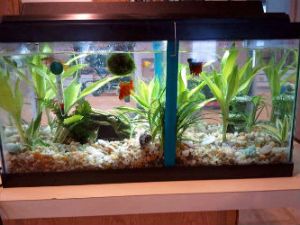
Offering Betta tank dividers great for separating rough fish or for breeding
 When they are 4 months old, Bettas are ready to have babies. The male will make tiny bubbles on the surface of the water. It's called a bubble nest. Females will get rounder, and a small white tube will stick out of their bellies.
When they are 4 months old, Bettas are ready to have babies. The male will make tiny bubbles on the surface of the water. It's called a bubble nest. Females will get rounder, and a small white tube will stick out of their bellies.The name for this is an egg tube. The things you need to breed bettas are: 1 ten gallon tank 1 stone-made air pump 1 cup of Styrofoam (cut in half lengthwise) 1 glass lantern 1 aquarium heater 1 bottle methylene blue (lasts several spawns) 1 very large amount of patience 1 pair with a condition 1 thermometer for an aquarium 1 unknown black snail To train the pair, they need to eat a lot of different things, including some live foods. Every day, they have to change their water, and they can't see each other until the 12th day. I like to get my males ready for breeding in the breeding tank. The water level shouldn't be more than 5 "deep maximum. The breeding tank's temperature should slowly rise to 80F. The open end of the half-Styrofoam cup should face the glass. (A piece of Scotch tape will help keep it in place) Under the cup, the male will build his nest.
On day 12, you should notice that the female is getting bigger as she lays eggs. Put her container right next to the male's so he can see her. Put the glass hurricane into the breeding tank on day 14. The woman should be put into the hurricane. The hurricane will keep the man from getting too close to her. Since bettas usually breed when the sun comes up, I like to take out the hurricane at night, when the lights are out. As the eggs fall to the bottom, the male wraps his body around the female and fertilizes them. Together, they will go to the bottom, pick up eggs, and put them in the bubble nest. The eggs are small and look like grains of rice. At 80F, they take 24 hours to hatch and are white. If you put one drop of methylene blue in the cup next to the egg, the egg won't get fungus. When the fry hatch, they have a yolk sac that will feed them for about 24 hours.
Once they can swim, they don't need the yolk sac as much. For the first four days, they will need to eat infusoria until they are big enough to eat newly hatched brine shrimp. (Natural infusoria is made in the breeding tank by putting live plants and a black mystery snail). Since brine shrimp take 24 hours to hatch, you need a hatchery by the time your betta fry hatch.
It's easy to make your own hatchery. You'll need to: 1 2 liter soda bottle some air line 1 air pump 1 box kosher salt 1 tube brine shrimp eggs 1 Drill a hole in the bottle's lid. Put the air hose into the hole in the lid. Pour dechlorinated water, 1 tablespoon of kosher salt, and 1/8 teaspoon of brine shrimp eggs into the bottle until it's just over half full. The air hose should be long enough to reach the bottom of the bottle. Hook up the other end to the air pump. For the eggs to hatch, they have to move around. The "hatchery" should be put somewhere warm and well-lit. When they hatch, they are orange and very small. Because the shrimp's yolk sac is the most nutritious part, you should only use shrimp that are 24 hours old or younger. Stop the flow of air for 10 minutes. The shells that are empty will float to the top. The easiest way to get the shrimp out of the bottle is to siphon them into a funnel lined with a coffee filter. Before feeding the shrimp, they should be rinsed with water that has been treated to remove chlorine. Pull the shrimp and water out of the filter with a new, clean medicine dropper.
If you throw it into the tank, the fry will eat like crazy. The orange color of their bellies shows that they have eaten. They will eat the baby brine shrimp until they are about two months old, at which point you can start giving them flake and other foods. It is smart to keep two hatcheries going so that you never run out. The fry need to be fed five times a day. The 1/8 t of brine shrimp eggs should be enough to feed the shrimp for 24 hours.
When the fry are 4 days old, the dad should be taken away. Wrap the tank in plastic wrap to keep it moist so the labyrinth can grow. Around week 4, they build the labyrinth. You can also slowly add 1 to the water depth starting in week 4 "per week. At least once every other day, the water should be changed. (30% starting at day 4) When the fry are a week old, you can add a small sponge filter. To replace the water that has been changed, put dechlorinated water in a bucket or jug and put it on top of the tank. Put it back in the tank with the syphon, because sudden movement can hurt the fry.